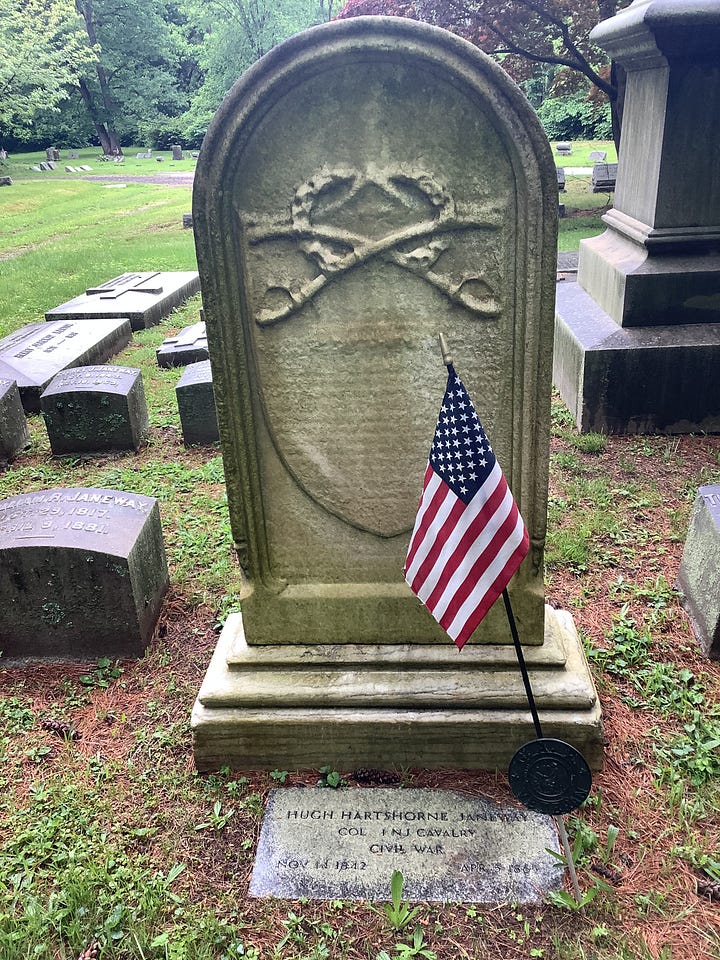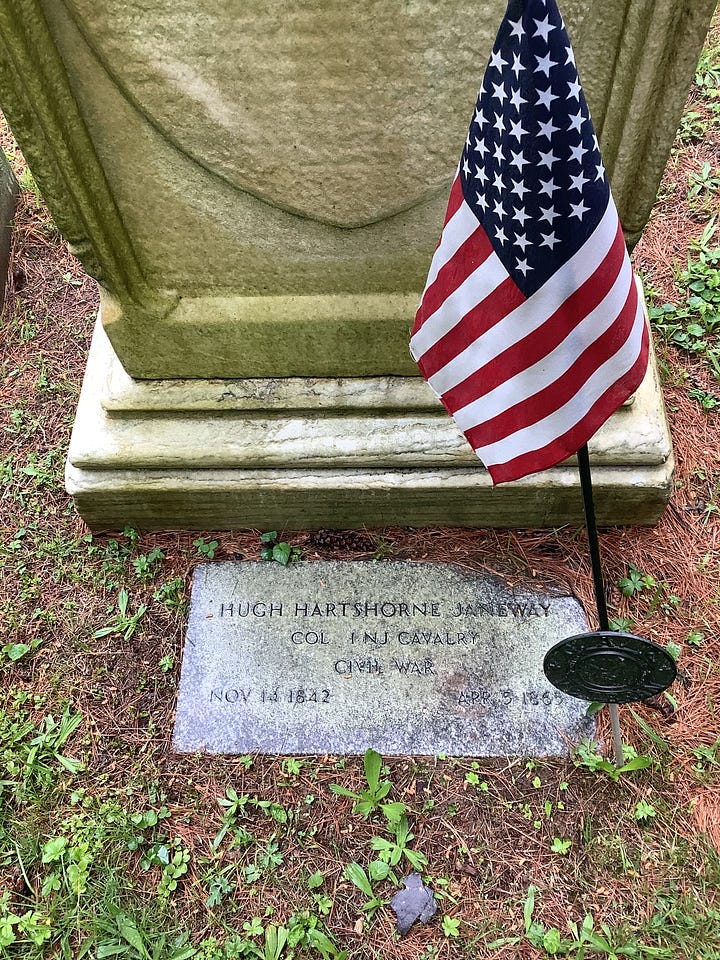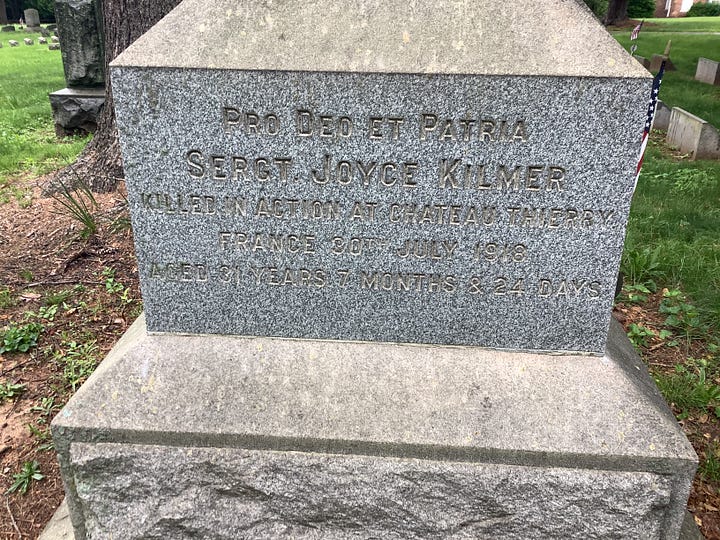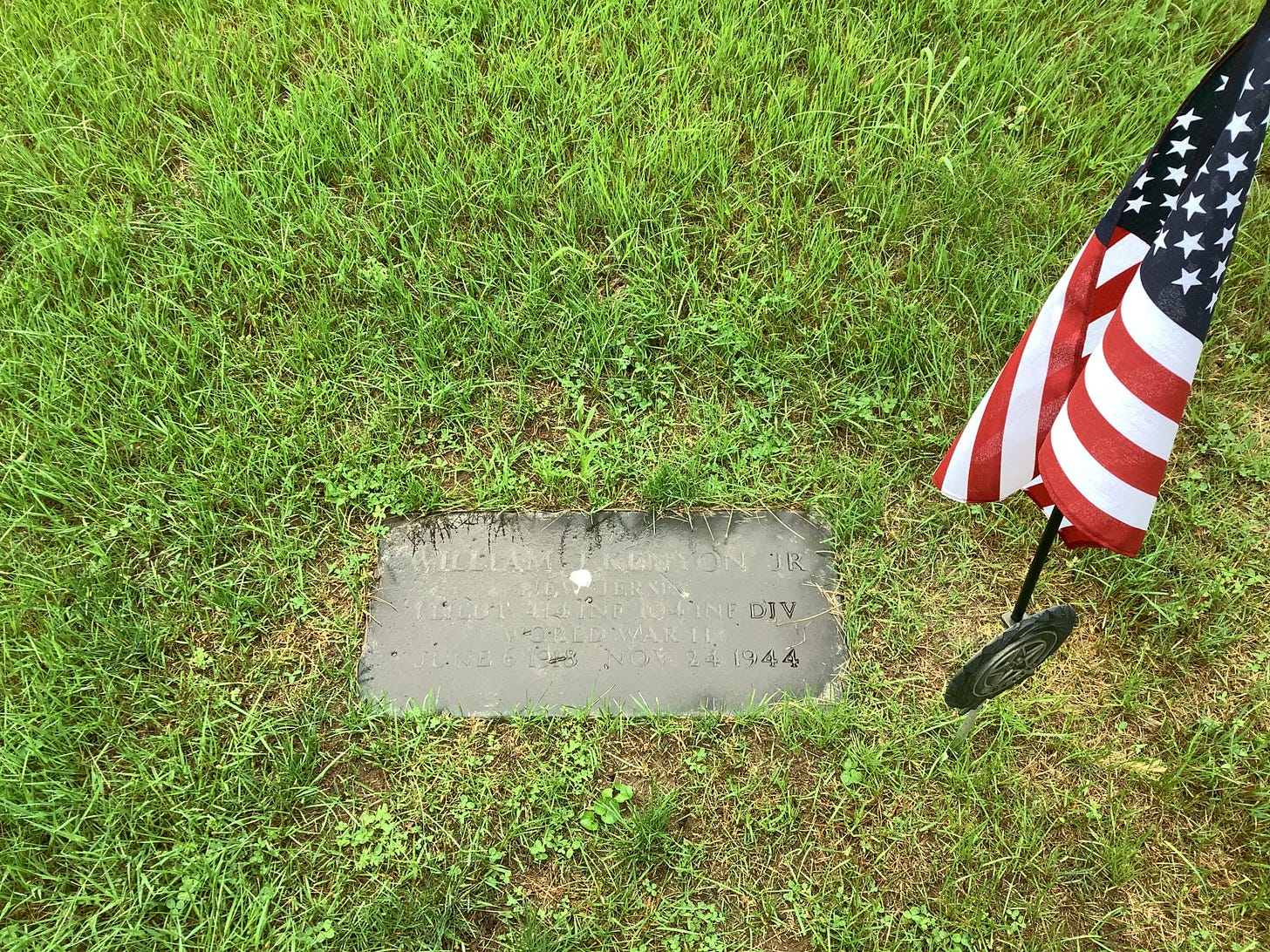Memorial Day is a time to remember and honor those who gave the ultimate sacrifice during their military service. Begun in the years after the Civil War, the holiday served as a way for Americans to honor those who lost their lives in that conflict; it has since served as a chance to honor American service members from every conflict and branch of the military, officially becoming a federal holiday in 1971. In honor of Memorial Day, I thought it would be nice to highlight and remember the stories and sacrifice of five individuals memorialized at Elmwood Cemetery who lost their lives during their military service.


Hugh Janeway, who is buried at Elmwood Cemetery, helped to organize the 1st NJ Cavalry Regiment and was made a Lieutenant. The 1st NJ Cavalry fought in many battles and Janeway would himself be injured in battle multiple times, but he would continue to fight. Ultimately, he would be promoted to a Colonel. He would fight in the Appomattox Campaign until he was killed in battle at Amelia Springs just days before General Lee’s surrender. He was remembered by his fellow soldiers from New Brunswick, which named their local Grand Army of the Republic post Kearney-Janeway Post No. 15. As Janeway was killed inn action before the founding of Elmwood a cemetery, he was initially laid to rest in a vault on his family’s property.


Joyce Kilmer was already a very successful man before his military service. His father was the chief scientist at Johnson & Johnson and Joyce was a published poet. Perhaps his most well known piece of poetry is Trees, which is spoken nationwide by many on Earth Day and Arbor Day. Needless to say, Kilmer already had a remarkable life to the point he joined the fight in World War I.
Kilmer would be shipped overseas on October 29, 1917, departing Hoboken enroute to France. Kilmer’s main role was as an intelligence officer, collecting data on the enemy. By the beginning of March, 1918, he had received the rank of Corporal. On March 7, while in the Rouge Bouquet section of Parroy Forest, the regiment would be struck by a devastating bombardment by the Germans. Many soldiers were killed in the attack, including nineteen in one dugout.
Influenced by this experience, Kilmer would write the poem Rouge Bouquet. It would be read by Chaplain Francis P. Duffy during the funeral for the lost soldiers. Later that March, Kilmer would receive the rank of sergeant. In July of 1918, while scouting the locations of enemy machine guns, Sgt. Joyce Kilmer would be killed by a sniper’s bullet. He would leave behind his wife and four children. For his service he would posthumously receive the Croix de Guerre, awarded to him by the French government.
Frederick Howell was born on April 29, 1924 to Bertram and Virginia Howell. Frederick grew up in Highland Park and would attend school at Rutgers Prep and the Peddie School in Hightstown. He was involved in many activities, from athletic endeavors, like wrestling, to other academic endeavors like serving on the Peddie School newspaper, the yearbook staff, and becoming the president of the school Camera Club. He also learned to play multiple instruments. His favorite activity was Rifle Club, where he quickly distinguished himself as a skilled marksman. After graduating high school in June of 1943, Fred enlisted in the US Army. He had intended to enlist as an aviation cadet, but his request was not granted, and on August 11, 1943 he was inducted into the Army as a Private and sent to Camp Dix and then Fort Benning for basic training.
He would be sent all over for Army Specialized Training, going from Cornell University, to Louisiana, to Texas, to Kentucky, and eventually back to New York State. He would continue to demonstrate what a good shot he was, participating in a marksmanship competition in Camp Breckinridge where he won first place a sack of 100 silver dollars.
Howell would eventually be shipped overseas to the battlefields of Europe. He was assigned to a sharpshooter unit and went into action in the Battle of the Bulge. Given the battle’s high casualty rate, it was unfortunately little surprise that an officer as skilled as Howell would eventually be put into harm's way. On Christmas Eve, 1944, Private First Class Frederick Suydam Howell was killed on the Front lines in Belgium. He would posthumously be awarded the Purple Heart.
Another soldier who was killed in action right before the Battle of the Bulge was Lt. William Kenyon Jr.. Only 26 when he passed away, he had little chance to distinguish himself, despite being quite popular with his peers. His mother has entered the history books as the first female scientist at Johnson & Johnson, but he was never able to develop a legacy of his own before his passing. His mother, nearly 60 when he passed away in November of 1944, would outlive her son by another 40 years, passing away at the age of 101. He would repatriated to the United States in 1948, where he would be buried at Elmwood Cemetery in his family’s lot.
The last veteran I want to highlight today is Carlos Blake Needham Jr. The son of an a well respected and successful family, it was assumed he would be a fixture of the New Brunswick area for a long time. However, with the outbreak of World War II, both he and his brother, Lewis, would opt to serve. Carlos would join the Army, being sent overseas to help liberate the Philippines from Japanese occupation. He must have known that the war would be over soon, as the war had ended in Europe earlier that year. Tragically, Technician Fifth Grade Carlos Blake Needham Jr. would be killed in action on August 9, six days before Japan would declare a ceasefire that would lead to their surrender in September. Initially buried in the Philippines, he would be repatriated to Elmwood Cemetery in 1948.
Thank you all for reading and appreciating the stories of these brave men who served so valiantly. They made the ultimate sacrifice and on Memorial Day the least we can do is remember them. Before I sign off, I have a programming note. Starting with our next post the Elmwood Cemetery blog will now be updating monthly instead of weekly. With that in mind, I hope you all return in June. Thanks again!
Sources:
Burge, Dave. “A Look Back at History, Meaning of Memorial Day.” KARK, May 26, 2025. https://www.kark.com/news/national-news/a-look-back-at-history-meaning-of-memorial-day/#:~:text=The%20first%20Memorial%20Day%20was,was%20originally%20called%20Decoration%20Day.
Burgholzer, Paul. “Remembering the Rainbow Division.” The United States World War One Centennial Commission, 2017. https://www.worldwar1centennial.org/index.php/communicate/press-media/wwi-centennial-news/2975-remembering-the-rainbow-division.html.
Clayton, W. Woodward. History of Union and Middlesex Counties. Philadelphia, PA: Everts & Peck, 1882
Durnin, Richard G. Joyce Kilmer and New Brunswick, New Jersey. New Brunswick: Middlesex County Cultural and Heritage Commission, 2006.
Grossman, Iris. “Meet Fred Kilmer: One of Johnson & Johnson’s Earliest Pioneers.” Johnson & Johnson, December 14, 2016. https://www.jnj.com/our-heritage/fred-kilmer-johnson-and-johnson-scientific-pioneer.
James, D. Clayton. The Years of MacArthur: Vol. 1, 1880-1941. Boston: Houghton Mifflin Company, 1970.
“Joyce Kilmer.” Poetry Foundation. Accessed March 28, 2024. https://www.poetryfoundation.org/poets/joyce-kilmer.
Frederick S Howell in US, WWII Army Enlistment Records, 1938-1946.” Fold3. Accessed May 21, 2024. https://www.fold3.com/record/91337999/frederick-s-howell-us-wwii-army-enlistment-records-1938-1946.
“Frederick S. Howell.” American Battle Monuments Commission. Accessed May 21, 2024. https://www.abmc.gov/decedent-search/howell%3Dfrederick.
“Glorianna Gibbon Obituary.” The Daily Record. October 18, 2016.Lee, Francis Bazley. The Genealogical and Memorial History of the State of New Jersey. New York, NY: Lewis Historical Publishing Company, 1910.
Keane, James T. “Joyce Kilmer: Soldier, Writer and Lost Voice in the American Catholic Literary Revival.” America Magazine, May 30, 2023. https://www.americamagazine.org/arts-culture/2023/05/30/cbc-column-joyce-kilmer-245388.
Stockton, R.F. Report of the Operations of the First New Jersey Cavalry, From the 28th of March to the 25th of May, 1865, With a Portion of the Number of Engagements in Which the Regiment has Participated, and a Complete Roster of the Commissioned Officers. Trenton, NJ: True American Office, 1865.
"US,World War II Draft Registration Cards, 1940," digital images, Fold3.com, Frederick Suydam Howell, serial no. 553, order no. 20527, Local Board No. 2, Middlesex County, New Jersey; citing US, Selective Service Registration Cards, World War II: Multiple Registrations, 1940, NARA Record Group 147, Roll 44025_06_00043.





